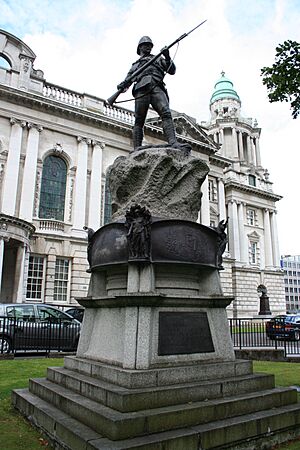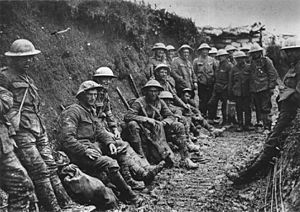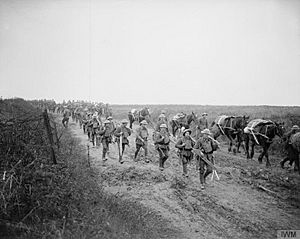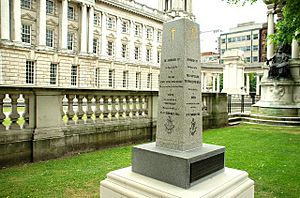Royal Ulster Rifles facts for kids
Quick facts for kids Royal Irish RiflesRoyal Ulster Rifles |
|
|---|---|

Cap badge
|
|
| Active | 1881–1968 |
| Country | |
| Branch | |
| Type | Light infantry |
| Role | Anti-tank warfare Artillery observer Bayonet charge Close-quarters battle Cold-weather warfare Counterinsurgency Desert warfare Raiding Reconnaissance Trench warfare Urban warfare |
| Size | 1-2 Regular battalions 3 Militia and Special Reserve battalions Up to 16 Hostilities-only battalions |
| Garrison/HQ | RHQ – Victoria Barracks, Belfast (1881-1937) St Patrick's Barracks, Ballymena (1937-1968) |
| Nickname(s) | The Stickies, The Rifles |
| Motto(s) | Quis Separabit (Who shall separate us [from the love of Christ]) (Latin) |
| Colours | None as a rifle regiment |
| March | Quick: "The Ulster Rifles march 'Off, Off, Said the Stranger'" Pipes and Drums: "South Down Militia" |
| Anniversaries | Somme Day, 1 July |
| Engagements | Badajoz, Jhansi, Somme, Normandy Landings, Rhine Crossing, Korea |
| Insignia | |
| Abbreviation | RUR (RIR) |
The Royal Irish Rifles was a special army group known for being light infantry. It was first formed in 1881. This group was created by joining two older regiments: the 83rd (County of Dublin) Regiment of Foot and the 86th (Royal County Down) Regiment of Foot.
Later, on January 1, 1921, the name changed to the Royal Ulster Rifles. This regiment fought in several big wars, including the Second Boer War, the First World War, the Second World War, and the Korean War.
In 1968, the Royal Ulster Rifles joined with two other regiments, the Royal Irish Fusiliers and the Royal Inniskilling Fusiliers. Together, they formed a new group called the Royal Irish Rangers.
Contents
A Look Back: The Regiment's History
How It All Started

The story of this regiment began a long time ago, during the reign of King George III in 1793. At that time, the British Army needed more soldiers for a war with France. So, they created two new regiments: the 83rd and the 86th.
In 1881, these two regiments combined to form the Royal Irish Rifles. This was part of a big army change called the Childers Reforms. The new regiment was based in Ireland, with its main office at Victoria Barracks, Belfast.
Fighting in the Boer War
The Royal Irish Rifles faced tough battles during the Second Boer War in South Africa. They suffered many losses at the Battle of Stormberg in December 1899.
To remember the 132 soldiers who died, a special memorial was put up in 1905. You can still see it today at Belfast City Hall.
The First World War Experience
During the First World War, many battalions (smaller groups of soldiers) from the Royal Irish Rifles fought bravely.
The 1st Battalion went to the Western Front in November 1914. They fought in major battles like Battle of Neuve Chapelle and Battle of Loos. They also took part in the huge Battle of the Somme in 1916.
The 2nd Battalion arrived in France in August 1914. They were involved in some of the earliest and toughest battles, including the Battle of Mons and the First Battle of the Marne. By the end of 1914, most of the original soldiers in this battalion had been killed, injured, or captured.
New Battalions Join the Fight
Many new battalions were formed to help in the war effort. For example, the 6th Battalion fought in Gallipoli and later in Palestine.
Other battalions, like the 8th, 9th, 10th, 11th, 12th, 13th, 14th, 15th, and 16th, all served on the Western Front. These groups were made up of soldiers from different parts of Ireland.
Sadly, about 7,010 soldiers from the Royal Irish Rifles lost their lives during the First World War.
Between the Big Wars
After the First World War, the army decided to give the Royal Irish Rifles a new name. This was to make sure that Ulster, a region in Ireland, had its own special place in the army.
So, from January 1, 1921, the regiment became known as the Royal Ulster Rifles. In 1937, they moved their main base to St Patrick's Barracks.
The Second World War Role
Regular Army Battalions
When the Second World War began, the 1st Battalion was in India. They were trained for mountain warfare. Later, they became a special glider-borne unit, meaning they would fly into battle in gliders.
This battalion took part in Operation Mallard on D-Day, June 6, 1944. They landed in France using Horsa gliders as part of the 6th Airborne Division. They fought bravely in the Battle of Normandy.
They also participated in Operation Varsity in March 1945, which was a huge airborne attack to cross the Rhine River into Germany.

The 2nd Battalion was part of the British Expeditionary Force (BEF) in France from 1939 to 1940. They fought in the Battle of Dunkirk and were later evacuated from France.
This battalion returned to France for the D-Day landings in June 1944. They were among the first British troops to enter the city of Caen during the Operation Charnwood battle.
Other Battalions and Roles
Other battalions, like the 6th and 7th, were formed for home defense, often made up of older soldiers. The 8th Battalion even changed roles and became an anti-aircraft regiment. They fought in North Africa and Italy.
After the Wars: The Korean War
In 1948, the 1st and 2nd Battalions combined to form a single 1st Battalion, Royal Ulster Rifles.
This battalion was sent to the Korean War in November 1950. They fought in tough conditions against Chinese Communist forces.
One of their most famous battles was the Battle of the Imjin River in April 1951. The Royal Ulster Rifles, though greatly outnumbered, held their ground. Their bravery helped stop the enemy from capturing Seoul, the capital of South Korea.
For their actions at Imjin River, soldiers received many awards for their courage. A memorial was built to honor the 208 men who died or went missing in that battle. This memorial is now located at Belfast City Hall.
Even after the Korean War, the regiment continued to recruit soldiers from all over Ireland. In July 1968, the Royal Ulster Rifles joined with two other regiments to form the Royal Irish Rangers.
Regimental Museum
You can learn more about the Royal Ulster Rifles at their museum. It's located in the Cathedral Quarter, Belfast. The museum has uniforms, badges, medals, and many other items that tell the story of the regiment.
Brave Heroes: Victoria Cross Recipients
The Victoria Cross is the highest award for bravery in the British military. Several soldiers from the Royal Irish Rifles and its earlier regiments received this honor:
- Lieutenant Hugh Cochrane, 86th Regiment, 1858
- Lieutenant Henry Edward Jerome, 86th Regiment, 1858
- Private James Byrne, 86th Regiment, 1858
- Private James Pearson, 86th Regiment, 1858
- Rifleman William McFadzean, 14th Battalion, 1916 (at the Battle of the Somme)
- Rifleman Robert Quigg, 12th Battalion, 1916 (at the Battle of the Somme)
- Second Lieutenant Edmund De Wind, 15th Battalion, 1918
Memorials to Remember
There are several memorials dedicated to the soldiers of the Royal Irish Rifles, especially those who fought in the First World War:
- Ulster Tower Memorial in Thiepval, France
- Irish National War Memorial Gardens in Dublin
- Island of Ireland Peace Park in Messines, Belgium
- Menin Gate Memorial in Ypres, Belgium
- War Memorial of Korea in Seoul, South Korea
Alliances
The Royal Ulster Rifles had a special connection with the 2nd Battalion, Singapore Infantry Regiment in Singapore.
See also
- List of British Army regiments (1881)
- Young Citizen Volunteers





